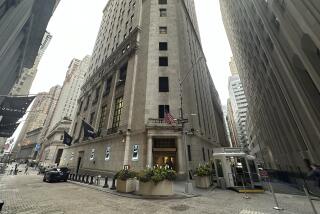Unemployment Rate Posts Slight Rise to 4%
WASHINGTON — The U.S. economy produced fewer new jobs than expected in November, nudging up the unemployment rate to 4% from a 30-year low, the government reported Friday.
The tenth-of-a-point rise in unemployment, together with a smaller-than-expected, 94,000-job bump in payrolls, included few of the signs of abrupt slowdown contained in other recent snapshots of the economy. As a result, the numbers were taken as reassuring evidence that the nation is on track for a “soft landing” of slower growth, but no recession.
But the new report included broad hints about who will get hurt first and most severely if the economy slows sharply--minorities, the young and the less-educated. For instance, unemployment among Latinos rose a full point, to 6.1 %.
In trading before the Florida Supreme Court’s surprise decision in the presidential election, investors sent the tech-heavy Nasdaq composite index up 164.77 points, or 6%, to 2,917.43. They pushed the broader Standard & Poor’s 500 index up 26.34, or 2%, to 1,369.89, and the Dow Jones industrial average up 95.55, or 0.9%, to 10,712.91.
“These are ‘soft landing’ numbers and nothing more serious,” said Brian M. Jones, an economist with Salomon Smith Barney Inc. in New York.
Still, there were signals that the economy is losing steam, and a considerable amount more than most people thought possible even a few months ago.
In a separate report, the University of Michigan said its December consumer sentiment index registered the biggest one-month drop in more than a decade, tumbling from 107.6 to 97.4. The index is considered a key indicator of whether individual Americans, who account for two-thirds of the nation’s spending, will keep buying or cut back.
The jobs report itself contained some hints that a sharper-than-expected slowdown could be in the making:
* Forecasters had thought the economy would add 148,000 new jobs last month, rather than the 94,000 reported by the government. In fact, the private sector lived up to expectations, but local governments unexpectedly trimmed payrolls by 54,000.
* Manufacturing employment held firm in November, according to the Labor Department report. But almost nobody believes that will continue this month, as auto companies, computer producers and equipment makers ratchet back production. General Motors Corp., the No. 1 auto maker, announced Thursday that it is slashing first-quarter production by 14% to its lowest level in five years.
* The number of part-time workers who wanted full-time jobs, a category that had fallen to all-time lows in recent years, suddenly jumped by 277,000 to 3.47 million. “These are people edging their way toward unemployment,” said John Youngdahl, a senior economist with Goldman, Sachs & Co. in New York.
The new unemployment rate for Latinos was the highest level in more than a year, while the rate for blacks rose slightly, to 7.4%. The rate for workers with less than a high-school degree climbed to 6.7%, which was more than half a point above its all-time low in August, while that for college graduates fell to 1.5%, which was almost half a point below its August level.
Most analysts said the new jobs report is the last sign of economic slowing that the Federal Reserve needs to begin reversing its higher interest rate fight against inflation and begin cutting rates. But few predicted the central bank will act quickly.
At least in part, that’s because wages are continuing to climb at a moderately speedy pace. Average hourly earnings were up 0.4%, or 6 cents, last month, the same as in October, according to the government. That was slightly faster than most forecasts and was the sort of trend that worries Fed policymakers, who fear that higher wages can lead to higher prices and set off a wage-price spiral. Over the last year, average hourly earnings have risen 4%.
The Fed’s policymaking body, the Federal Open Market Committee, meets Dec. 19.
The length of the workweek continued its near yearlong erosion, slipping from 34.4 hours in October to 34.3 hours last month, according to the new report. Manufacturing overtime also fell, from 4.5 hours in October to 4.3 hours in November.
Nevertheless, the economy continued to show strength with the jobless rate remaining firmly in the 3.9%-to-4.1% range, where it has resided since October 1999.
“Overall, the economy is behaving very well,” said William Cheney, chief economist with John Hancock Financial Services in Boston. “We’re slowing, not stumbling.”
(BEGIN TEXT OF INFOBOX / INFOGRAPHIC)
U.S. Unemployment
Percentage of U.S. work force not employed, seasonally adjusted:
November: 4.0%
Source: Labor Department
More to Read
Inside the business of entertainment
The Wide Shot brings you news, analysis and insights on everything from streaming wars to production — and what it all means for the future.
You may occasionally receive promotional content from the Los Angeles Times.










